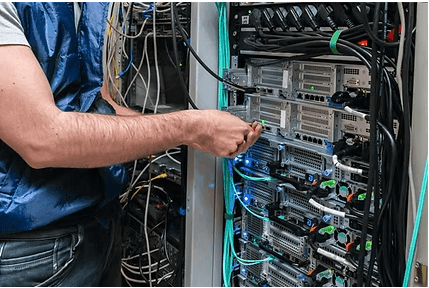Upgrade or Virtualize Vital Network Infrastructure
Business success no longer depends on hardworking employees and high-end equipment. With the rise of technology in and out of the workplace companies must adapt and utilize different technological tools to stay competitive in today’s job market. For example, implementing a well-conserved network infrastructure brings a lot of immediate benefits to a company but failing to update such tools can bring down your business equally as fast. An unsecured network is an open invitation for cybercriminals to access sensitive company data and wreak havoc on your operations. If you don’t have the right network security solutions and protocols in place, you could be putting your business at risk.

The Benefits of Updating
A downgraded infrastructure leaves businesses exposed to a variety of threats that can terminate business operations. On the other hand, an updated network paired with quality network security solutions give companies the following benefits:
Increased productivity
A slow or unreliable internet connection can be a major drag on productivity. When employees are constantly having to wait for pages to load or for files to download productive time is significantly reduced. A virtualized and updated network improves employee efficiency by providing them with a fast and reliable internet connection to perform their daily duties.
Faster Internet Connection
Older networks are not made to support today’s internet demands. Services such as streaming video, cloud-based applications, and VoIP require more bandwidth. An older network won’t be able to provide the infrastructure modern businesses need to accomplish fundamental tasks. A virtualized network can help to meet these demands by providing a faster and more reliable internet connection.
Reduced Maintenance and Management Times
Older networks require more maintenance to function properly. An upgraded network allows in-house or managed IT staff to manage the infrastructure easily and, in less time, allowing them to concentrate on more cost-effective tasks.
What about Virtualized Network Infrastructure?
A virtual network uses software to emulate the functions of traditional infrastructure. Businesses with virtualized structures enjoy the perks of an upgraded system as well as gain some extra benefits thanks to virtualized network’s cloud-based nature.
Remote Work-Friendly With a proper internet connection, employees can access the network from anywhere making it ideal for businesses that prefer remote working.
Increased Security and Data Protection
Having effective network security solutions are essential for business operations. Virtual networks function on multilayered security architecture to protect this architecture, which is divided into two main categories:
- Network Access Control: Its primary function is to “hide” the map of an infrastructure of a network and restrict movement from external threats.
- Threat Control: This prevents external threats from applying changes in the network.
- Providing Network Access Control and Threat Control
- Network-Based Firewall: Establishes a barrier between trusted and untrusted parts of the network.
- Load balancer: Helps the system distribute the work equally and manages a network’s workload to prevent and absorb attacks.
- IDS/IPS: Intruder Detection Systems (IDS) and Intruder Protection Systems (IPS) are both deployed in your virtual network to protect your data. IDS protects your network against malicious traffic and alerts the administrator when any suspicious activity is detected. On the other hand, IPS identifies, informs, and prevents malware attacks.
- NTA/NDR: Network Traffic analysis (NTR) and Network Data Response (NDR) both use machine learning algorithms to evaluate and determine if a threat is present in the network.
Centralized Management
Create multiple isolated virtual networks that function with the same physical infrastructure. Changes in the network don’t require hardware configuration, allowing IT Teams to easily manage networks from anywhere without the need for onsite hardware management.
Scalability
Automatization, network applications, and virtual upgrades allow virtual networks to manage change in work demands without affecting productivity or network performance. Updating your network is just as important as obtaining one. In BTI we are aware that companies need their systems working at peak performance. That is why we offer our clients scaled network infrastructure & network security solutions for their business designed to fit your specific needs and budget.
Virtual Private Networks
A VPN or Virtual Private Network uses the internet to connect two or more private networks with each other. VPNs also allow users to connect remotely to physical networks that are part of the infrastructure. Virtual Private Networks protect users’ privacy by masking IP addresses to ensure secure browsing from any network. This makes the digital environment a threat-free zone for all users.
If you would like to know more about updating your network infrastructure & network security solutions, please contact us to schedule a free business assessment. You can also call or text us at 562-298-5000





